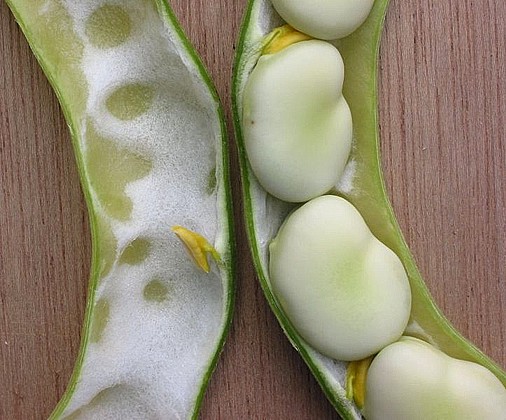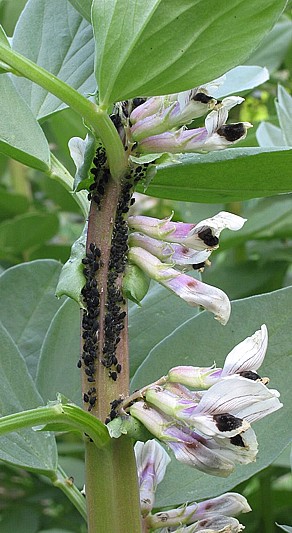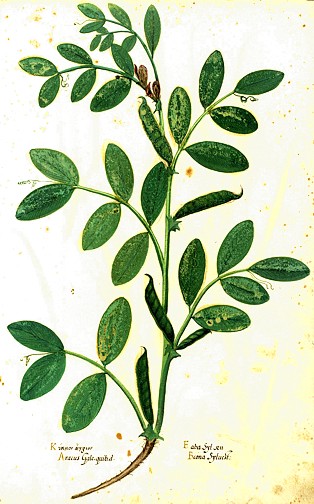Lessico
Fava
e Veccia
Vicia faba - Vicia sativa

Vicia: genere di piante erbacee della famiglia Leguminose comprendente circa 120 specie proprie delle regioni temperate dell'emisfero boreale e dell'America Meridionale. Annue o perenni, hanno fusto esile, spesso angoloso, con foglie pennate e un viticcio terminale; i fiori, solitari o in racemo, sono blu, violetti, rossi, giallicci o bianchi.
Il frutto è un legume con pochi semi. Alcune specie sono coltivate in agricoltura per l'alimentazione umana o del bestiame: tra queste, le più importanti sono la fava, Vicia faba = Faba vulgaris, la veccia, Vicia sativa; Vicia villosa e Vicia narbonensis. Molto spesso poi le veccie si trovano come infestanti nelle colture, come Vicia cracca, dai lunghi racemi violetti.
È il
medico inglese Gerald Hart a mettere in evidenza che per Pitagora![]() e i sui seguaci il divieto di cibarsi di fave aveva dei precisi risvolti
profilattici che solo la medicina moderna ha potuto chiarire. Si veda il
lessico alla voce favismo
e i sui seguaci il divieto di cibarsi di fave aveva dei precisi risvolti
profilattici che solo la medicina moderna ha potuto chiarire. Si veda il
lessico alla voce favismo![]() .
.

Vicia faba, the broad bean, fava bean, faba bean, horse bean, field bean, tic bean is a species of bean (Fabaceae) native to north Africa and southwest Asia, and extensively cultivated elsewhere. Although usually classified in the same genus Vicia as the vetches, some botanists treat it in a separate monotypic genus as Faba sativa Moench.
It is a rigid, erect plant 0.5-1.7 m tall, with stout stems with a square cross-section. The leaves are 10-25 cm long, pinnate with 2-7 leaflets, and of a distinct glaucous grey-green colour; unlike most other vetches, the leaves do not have tendrils for climbing over other vegetation. The flowers are 1-2.5 cm long, with five petals, the standard petal white, the wing petals white with a black spot (true black, not deep purple or blue as is the case in many "black" colourings), and the keel petals white. The fruit is a broad leathery pod, green maturing blackish-brown, with a densely downy surface; in the wild species, the pods are 5-10 cm long and 1 cm diameter, but many modern cultivars developed for food use have pods 15-25 cm long and 2-3 cm thick. Each pod contains 3-8 seeds; round to oval and 5-10 mm diameter in the wild plant, usually flattened and up to 20-25 mm long, 15 mm broad and 5-10 mm thick in food cultivars. Vicia faba has a diploid (2n) chromosome number of 12, meaning that each cell in the plant has 12 chromosomes (6 homologous pairs). Five pairs are acrocentric chromosomes and 1 pair is metacentric.
Cultivation and uses
Broad beans have a long tradition of cultivation in Old World agriculture, being among the most ancient plants in cultivation and also among the easiest to grow. It is believed that along with lentils, peas, and chickpeas, they became part of the eastern Mediterranean diet in around 6000 BC or earlier. They are still often grown as a cover crop to prevent erosion because they can over-winter and because as a legume, they fix nitrogen in the soil. These commonly cultivated plants can be attacked by fungal diseases, such as Rust (Uromyces viciae-fabae) and Chocolate Spot (Botrytis fabae).
In much of the Anglophone world, the name broad bean is used for the large-seeded cultivars grown for human food, while horse bean and field bean refer to cultivars with smaller, harder seeds (more like the wild species) used for animal feed, though their stronger flavour is preferred in some human food recipes, such as falafel. The term fava bean (from the Italian name fava) is commonly used in the United States (especially for beans grown for human consumption), but is also seen elsewhere, especially in Mediterranean recipes (this language shift can also be seen in the common use of the term "arugula" in the US for what in the UK is called "rocket").
Culinary uses

Broad beans are eaten while still young and tender, enabling harvesting to begin as early as the middle of spring for plants started under glass or over-wintered in a protected location, but even the main crop sown in early spring will be ready from mid to late summer. Horse beans, left to mature fully, are usually harvested in the late autumn.
The beans can be fried, causing the skin to split open, and then salted to produce a crunchy snack. These are popular in China, and also in Thailand where their name means "open-mouth nut".
In the Sichuan cuisine of China, broad beans are combined with soybeans and chili peppers to produce a spicy fermented bean paste called doubanjiang.
In most Arab countries the fava bean is used for a breakfast meal called ful medames. Ful medames is usually crushed fava beans in a sauce although the Fava beans do not have to be crushed.
Health issues
Broad beans are rich in tyramine, and thus should be avoided by those taking monoamine oxidase (MAOI) inhibitors.
Raw broad beans contain vicine and convicine, which can induce hemolytic anemia in patients with the hereditary condition glucose-6-phosphate dehydrogenase deficiency (G6PDD). This potentially fatal condition, which is quite common in certain ethnic groups, is called "favism" after the fava bean.
Broad beans are rich in L-dopa, a substance used medically in the treatment of Parkinson's disease. L-dopa is also a natriuretic agent, which might help in controlling hypertension. Some also use fava beans as a natural alternative to drugs like Viagra, citing a link between L-dopa production and the human libido.
Other uses
In ancient Greece and Rome, beans were used in voting; a white bean being used to cast a yes vote, and a black bean for no.
In Ubykh culture, throwing beans on the ground and interpreting the pattern in which they fall was a common method of divination (favomancy), and the word for "bean-thrower" in that language has become a generic term for seers and soothsayers in general.
In Italy, broad beans are traditionally sown on November 2, All Souls Day. Small cakes made in the shape of broad beans (though not of them) are known as fave dei morti or "beans of the dead". According to tradition, Sicily once experienced a failure of all crops other than the beans; the beans kept the population from starvation, and thanks were given to Saint Joseph. Broad beans subsequently became traditional on Saint Joseph's Day altars in many Italian communities. Some people carry a broad bean for good luck; some believe that if one carries a broad bean, one will never be without the essentials of life. In Rome, on the first of May Roman families traditionally eat fresh fava beans with Pecorino Romano cheese during a daily excursion in the Campagna.
In ancient Greece and Rome, beans were used as a food for the dead, such as during the annual Lemuria festival. In some folk legends, such as in Estonia and the common Jack and the Beanstalk story, magical beans grow tall enough to bring the hero to the clouds. The Grimm Brothers collected a story in which a bean splits its sides laughing at the failure of others. Dreaming of a bean is sometimes said to be a sign of impending conflict, though others said that they caused bad dreams. Pliny claimed that they acted as a laxative. European folklore also claims that planting beans on Good Friday or during the night brings good luck.
Cultural references
The name and modern term Fabian derives from this bean. In the 1992 videogame Out Runners, an anthropomorphic broad bean character is featured on billboards and the start of the game called "Broad Bean," a parody of Bibendum (the Michelin man), presumably the mascot of the fictional company sponsoring the race, Sam Spree.
In the film The Silence of the Lambs, Hannibal Lecter mentions that he once ate the liver of a census taker "with some fava beans and a nice Chianti."
La fève est une plante annuelle de la famille des Fabacées (légumineuses), dont elle est le type. On la cultive pour ses graines comestibles. Le terme désigne aussi la graine qui, consommée à l'état frais ou sec, est l'un des légumes les plus anciennement cultivés.
Nom scientifique Vicia faba L., famille des Fabacées, sous-famille des Faboideae, tribu des Fabeae.
Il existe
trois types de fèves:
la fève maraîchère ou grosse fève (Vicia faba L. var. faba),
la fève fourragère ou féverole (Vicia faba L. var. minuta (hort.
ex Alef.) Mansf.).
la fève à cheval ou féverole à grain moyen (Vicia faba L. var. equina
Pers).
Description
Plante herbacée robuste, pouvant dépasser 1 mètre. Feuilles pennées terminées par une pointe. Folioles larges, de couleur glauque. Inflorescence en racème de deux à cinq fleurs (parfois fleur solitaire), à corolle blanche ou rosée, avec des taches noires sur les ailes. Le fruit est une gousse contenant des graines de forme ovale et aplatie avec une peau épaisse, les fèves.
Distribution
Plante originaire du Moyen-Orient, elle est cultivée dans le monde entier.
Culture
Plante peu exigeante, elle préfère la chaleur (température optimale de croissance autour de 20°C). Dans le sud de la France on la plante en février, prévoir deux ou trois graines par trou, à trois cm de profondeur au cas ou l'une d'entre elles ne germe pas. Un truc simple pour combattre la prolifération de pucerons noirs fréquents sur les tiges des fèves est de pulvériser une solution d'eau savonneuse (savon de Marseille).
Dans le sud-ouest (Tarn), elle est traditionnellement plantée à la Toussaint. Elle démarre avant les froids, végète l'hiver tout en développant son réseau racinaire. Au printemps, elle grandit très vite et fleurit dans la foulée. Les gousses peuvent alors être récoltées de mi-avril à fin mai. Les pucerons arrivent alors en fin de culture et ne sont pas trop gênants.
Économie
La récolte
mondiale de fèves s'élève à 4,75 millions de tonnes (FAO 2002), dont:
fèves vertes: 1,02 millions de tonnes
fèves sèches: 3,73 millions de tonnes.
Principales maladies

Aphis fabae
Anthracnose
(Ascochyta fabae),
Maladie des taches chocolat (Botrytis fabae).
Mildiou
Rouille
Principaux ravageurs
Anguillule des céréales (Ditylenchus dipsaci)
Bruche de la fève (Bruchus rufimanus)
Puceron noir de la fève (Aphis fabae)
Thrips du pois (Frankliniella robusta).
Utilisation
Elle est
farineuse avec une saveur prononcée de noisette et une texture onctueuse.
Elle est une excellente source d'acide folique et une source élevée de
fibres. Elle peut être consommée crue, mais sans la peau épaisse qui
contient des tanins. En Espagne, elle entre dans la composition du fabada, une
sorte de cassoulet.
En Italie, on la cuisine alla pancetta, avec des oignons et du lard. Au
Moyen-Orient, elle est consommée en purée, en beignets ou en salade.

Faba
acquarello![]() di Ulisse Aldrovandi
di Ulisse Aldrovandi